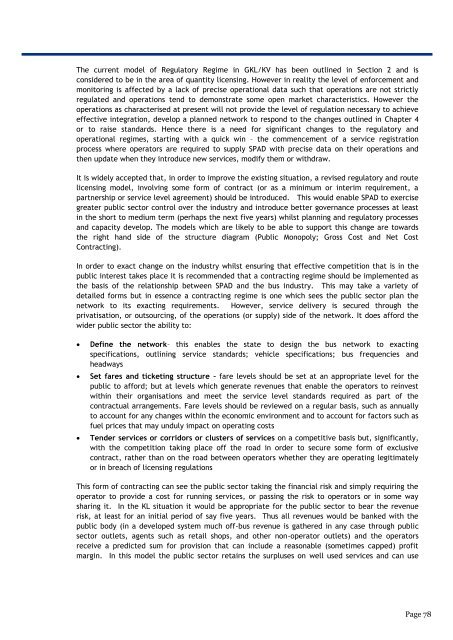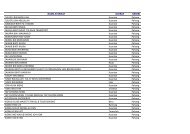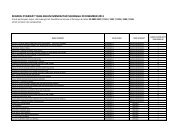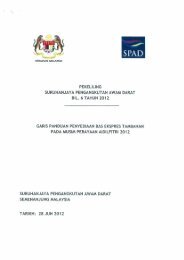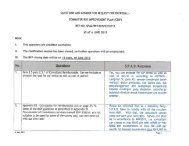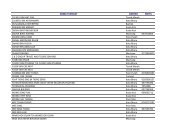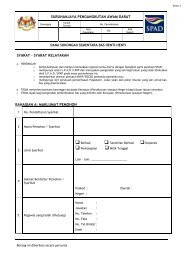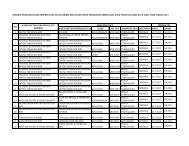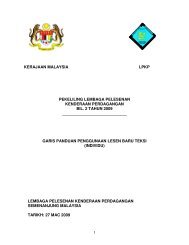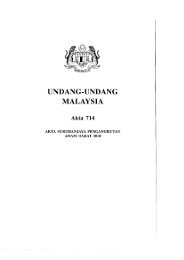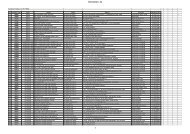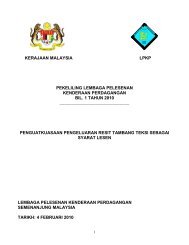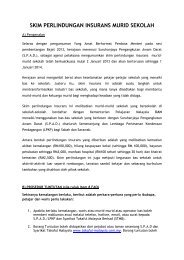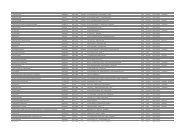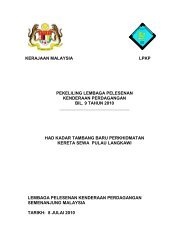Contents - SPAD
Contents - SPAD
Contents - SPAD
You also want an ePaper? Increase the reach of your titles
YUMPU automatically turns print PDFs into web optimized ePapers that Google loves.
The current model of Regulatory Regime in GKL/KV has been outlined in Section 2 and is<br />
considered to be in the area of quantity licensing. However in reality the level of enforcement and<br />
monitoring is affected by a lack of precise operational data such that operations are not strictly<br />
regulated and operations tend to demonstrate some open market characteristics. However the<br />
operations as characterised at present will not provide the level of regulation necessary to achieve<br />
effective integration, develop a planned network to respond to the changes outlined in Chapter 4<br />
or to raise standards. Hence there is a need for significant changes to the regulatory and<br />
operational regimes, starting with a quick win – the commencement of a service registration<br />
process where operators are required to supply <strong>SPAD</strong> with precise data on their operations and<br />
then update when they introduce new services, modify them or withdraw.<br />
It is widely accepted that, in order to improve the existing situation, a revised regulatory and route<br />
licensing model, involving some form of contract (or as a minimum or interim requirement, a<br />
partnership or service level agreement) should be introduced. This would enable <strong>SPAD</strong> to exercise<br />
greater public sector control over the industry and introduce better governance processes at least<br />
in the short to medium term (perhaps the next five years) whilst planning and regulatory processes<br />
and capacity develop. The models which are likely to be able to support this change are towards<br />
the right hand side of the structure diagram (Public Monopoly; Gross Cost and Net Cost<br />
Contracting).<br />
In order to exact change on the industry whilst ensuring that effective competition that is in the<br />
public interest takes place it is recommended that a contracting regime should be implemented as<br />
the basis of the relationship between <strong>SPAD</strong> and the bus industry. This may take a variety of<br />
detailed forms but in essence a contracting regime is one which sees the public sector plan the<br />
network to its exacting requirements. However, service delivery is secured through the<br />
privatisation, or outsourcing, of the operations (or supply) side of the network. It does afford the<br />
wider public sector the ability to:<br />
<br />
<br />
<br />
Define the network– this enables the state to design the bus network to exacting<br />
specifications, outlining service standards; vehicle specifications; bus frequencies and<br />
headways<br />
Set fares and ticketing structure – fare levels should be set at an appropriate level for the<br />
public to afford; but at levels which generate revenues that enable the operators to reinvest<br />
within their organisations and meet the service level standards required as part of the<br />
contractual arrangements. Fare levels should be reviewed on a regular basis, such as annually<br />
to account for any changes within the economic environment and to account for factors such as<br />
fuel prices that may unduly impact on operating costs<br />
Tender services or corridors or clusters of services on a competitive basis but, significantly,<br />
with the competition taking place off the road in order to secure some form of exclusive<br />
contract, rather than on the road between operators whether they are operating legitimately<br />
or in breach of licensing regulations<br />
This form of contracting can see the public sector taking the financial risk and simply requiring the<br />
operator to provide a cost for running services, or passing the risk to operators or in some way<br />
sharing it. In the KL situation it would be appropriate for the public sector to bear the revenue<br />
risk, at least for an initial period of say five years. Thus all revenues would be banked with the<br />
public body (in a developed system much off-bus revenue is gathered in any case through public<br />
sector outlets, agents such as retail shops, and other non-operator outlets) and the operators<br />
receive a predicted sum for provision that can include a reasonable (sometimes capped) profit<br />
margin. In this model the public sector retains the surpluses on well used services and can use<br />
Page 78


